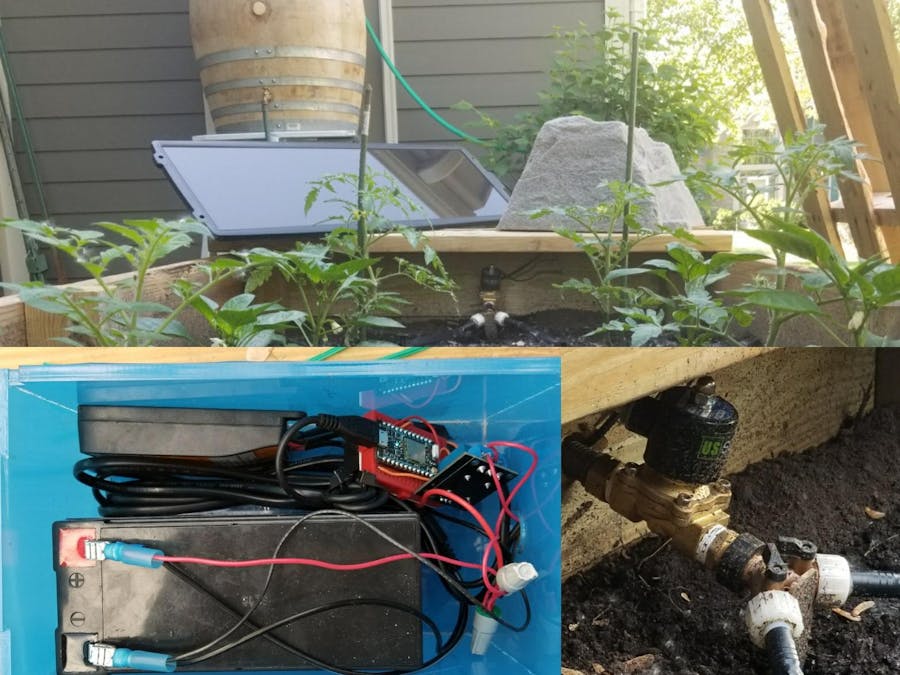3DSketchup Rendering
I started gardening three years ago as a therapeutic outlet to combat my boredom, and immediately fell in love with it. What started as a passing interest soon became a passion. However, the garden I tended was at my family's house, 12 miles away from where I lived. This meant that if I wanted to water my garden, I would have to drive a total of 24 miles, just to turn a simple valve.
I figured that this wasn't happening to just me. This made me consider all of the driving that goes into the process of food production in general, and all of the carbon dioxide produced as a result. For instance, when we drive to the grocery store, as most Americans do to get their food, we burn fossil fuels to get there. Likewise, the trucks that distribute that food from the farm to store are also burning immense amounts of fossil fuel along their trips. All of this driving back and forth is contributing heavily to the destabilization of our planet's climate, and is ultimately unsustainable.
I wanted to use my dual passions of horticulture and technology to do my part in addressing this problem. My solution: If more people start their own personal gardens, there will be less need for all this driving! Not only that, I think the more that people engage in the age-old human tradition of cultivating the land for food, the happier they will be.
As I set off on my research, I was happily surprised to find that gardening seems to be on the rise in the US. According to a report by the National Gardening Association, Garden To Table: A 5-Year Look At Gardening In America, one in three American households is now food gardening. The report goes on to state that the “total spent on food gardening rose 40% from $2.5 billion in 2008, to $3.5 billion in 2013.”
Though one-in-three is an impressive statistic, it would be nice to see this number rise even more over the next few years.
What is it that is keeping the other two thirds of Americans still driving back and forth from the supermarket to buy their tomatoes and cukes?
According to an article by Growertalks.com, time is "a leading factor regarding why people don’t garden. Most respondents stated that they lack the time due to variables such as work, family and other extracurricular activities. This made it clear that the opportunity cost of gardening was too high when compared to other activities."
Could automation be the missing piece for the busy and the time-crunched to finally take the plunge into adopting a horticultural practice of their own?
I think so. That is why Gutters to Gardens TechTOWER was developed, an open-source system for automating drip-line irrigation in raised garden beds.
I intend to provide people with tech-based solutions to common gardening problems. I'll start with my initial TechTOWER system depicted here, which gives people the ability to control the flow of water in their gardens remotely. Whether that is from their home, using AI assistants like Amazon's Alexa, or whether that's from their mobile phone at the cabin hours away, the TechTOWER solution will work just the same.
The TechTOWER in its current form, though, is only the beginning. With this technology, it would be possible to integrate automated temperature and humidity sensors as well as deploying components like fans, lights, and opening and closing vents. With this system, it would also be possible to connect a camera as a kind of horticultural version of a baby monitor. The opportunities for innovating off of this initial platform are diverse and exciting. TechTOWER isn't a product for people to buy; it is an open-source solution to a common problem, and others are free to adjust and improve upon it as needed. As more and more people begin incorporating solutions into the system, I hope to see a renaissance in sustainable energy and home food gardening across the globe.
Why not?
My designThe TechTOWER design is comprised of 5 sections:
- Water Collection
- Electronics
- The Raised Bed / Dripline
- Mobile Interface
- AI Interface
I used a 55 gallon wine barrel to collect rainwater from a gutter. This could be expanded to an array of multiple 55 gallon drums or a 500 gallon water container as desired.
The size is not important...what matters is how you use it.
You may want a pump. For my prototype this wasn't needed, but there may be situations in which it is. For instance, if the downspout of your gutter is far away from your garden, or if your water container is not raised.
If the water container is raised like my prototype, then a solenoid valve will work just fine, as gravity will do all of the work in moving the water. If the container is not raised, it will be necessary to use a pump instead.
In my design, the container was raised 30" off the ground in a structure designed to resemble a municipal water tower. The quirky design is not required, but comes highly recommended.
The following are the approximate expenses for the water collection section of the TechTOWER system. Costs may vary depending on location and market fluctuations.
You may like to lower the cost for your stand, you may choose to set your barrel on cinder blocks or some other resourcefulness thinking.
- 55 GALLON BARREL: $20
- BULK HEAD FITTING $5
- MATERIALS FOR WATER TOWER STAND: $170
- WATER COLLECTION TOTAL: $195
The electronic section of the TechTOWER system is comprised of seven separate components. These components are diagrammed in the figure attached to this page and listed below along with their approximate prices.
SOLAR PANEL ($75)
Solar panels start with a 15 Watt Solar Panel, which converts light energy into electrical energy.
100w SOLAR CHARGE REGULATOR ($25)
The solar panel is connected to a regulator, which ensures that its connected battery is not overcharged.
12 VOLT BATTERY ($20)
This battery is a rechargeable battery, which allows it to receive energy from the solar panel through the regulator.
12 to 5 VOLT CONVERTER ($10)
This component changes the output of the 12 volt battery into 5 volts, so as not to overpower the controller.
PARTICLE PHOTON ($20)
The Particle Photon is the controller of the entire system and the brain of the operation. It is managed through a mobile interface, and can be synced up to an AI assistant. It is comprised of two different general purpose input/output types:
- Digital: These give and receive yes/no and on/off signals.
- Analog: These give and receive signals of degree (e.g. a dimming light or a variable speed motor).
5 VOLT RELAY ($3)
In a reversal of the process the 12 to 5 volt converter performs, the 5 volt relay makes sure the 12 volt valve gets enough energy, despite its being connected to a controller that only works at a voltage of 5 or less.
12 VOLT SOLENOID VALVE ($35)
Depending on the various inputs to the controller, the solenoid valve will be told to open or close. When open, it will release the water collected from the rain into the raised bed.
Amazon Alexa($50)
ELECTRONICS TOTAL: $241.00
(NOTE: This is not limited to a 12-volt system. The same array may have the potential to be mapped onto a 24-volt system.)
Section 3: THE RAISED BED / DRIP LINEThe raised bed is, of course, where the plants are planted and where they receive water from the TechTOWER through a drip line irrigation system. A drip line irrigation system is essentially a segment of tubing with holes running along it, allowing water to be distributed to all the plants in the bed evenly. By mid June, I intend to release an instructional video on how to build a raised bed for growing food, as well as one on how to install a drip line.
- MATERIALS FOR RAISED BED: $100
- DRIP LINE: $12
- RAISED BED / DRIP LINE TOTAL: $112
I used an app called Blynk to allow remote access to the controller of the TechTOWER via a mobile device. The app uses a simple, drag-and-drop interface that requires no coding experience. Using the application builder within Blynk, an individual can set the necessary commands to run the system. Specific instructions on how this is done are listed below.
INSTRUCTIONS FOR MOBILE INTERFACE SETUP:
- STEP ONE: Download the Blynk app on your mobile phone.
- STEP TWO: Once you have downloaded and opened the Blynk app, select "New Project" and Enter your project name and then select the Particle device you're using (in this case, the Particle Photon) from the drop down menu. When you have completed these steps, click "Create".
- STEP THREE: You will be sent an authentication token via email. Enter this code into the web-based IDE Follow the instructions in the email. This authentication token encrypts your handshake with the Blynk server, so you are the only one who will be able interface with your Photon.
- STEP FOUR: Returning to the Particle app, click the plus "+" in lower right had corner to add components. In my prototype, I used three different components:
- Button: This is the on/off switch which connects to the digital pins in the Particle Photon.
- Eventor Settings: This component basically tells the TechTOWER to turn on or off automatically at given dates and times. A glorified Timer.
- Webhook Settings: This allows you to integrate local weather forecasts into your mobile interface to help inform your irrigation choices.
BLYNK APP: FREE
Particle, the company that produces the controller of my system, offers a resource they call Particle Library, which they describe as "a collection of reusable firmware code that can be easily added to one or many Particle projects." The firmware code entitled Library "EchoPhotonBridge" will program the Photon on the Web IDE to turn on and off through voice command. Additionally you will have to add the a skill in your Alexa app named "Particle Smart Home Bridge". To find this click on the hamburger in the upper left hand corner of the Alexa app, then Select "Skills"
Alexa App FREE
GRAND TOTAL: $548






















Comments
Please log in or sign up to comment.